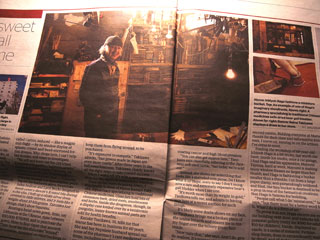暑い夏の日に、近所の知り合いに連れられて、彼女はふらりとぼくの作業場へ入ってきた。そしてアメリカ人独特のおもしろい日本語をあやつり、日本に住んで25年になること、名前はキット。ジャパンタイムスの記者をしていることなどを説明してくれた。ただちにギャラリーへ案内すると、スゴイ!スゴイ!を連発し、パシャパシャ写真を撮り始めた。キットは新聞記者であると同時にプロのカメラマンだそうだ。どうりでカメラがやたらとでかかった。
てっきり取材だと思い、待ち構えていると
「わたし、あした急にフロリダにかえることになりました。秋になったらまたきますので、よろしくおねがいします」
と、突然告げ、変わった形の名刺を一枚置いて、あっさり帰ってしまった。
やがて秋になり、師走になり、彼女のことはすっかり忘れていた。
そんな12月の中旬、「あなた、ワタシのこと、おぼえていますか?」というメールが舞い込み、師走の15日、キットが本当に、ふたたびやってきた。
「きのうのよる、麻布十番で、おサケのみすぎたよ、あたまフラフラだよ」
などと言いながら、ぼくのところでみっちり取材して帰り、そして後日、自分が書いたという新聞記事を送ってくれた。
(下の写真)
けっこう長い文章でぼくの仕事を紹介してくれ、ギャラリーのこともちゃんと宣伝してくれたおかげで、年末には「新聞を見た!」という来訪者がポロポロ訪れ、それは年明けまで続いた。
——–キットさんありがとう!
(下がその記事です)
Finding the workshop of 68-years-old Ichiyoh Haga is a bit tricky, but worth the hunt. Inside his studio, once a car garage, I find Haga and his apprentice, Mayumi Tayama, hard at work.
Mayumi is making teeny window frames no larger than her thumb, and Haga is fashioning a bucket smaller than a thimble. Cut from a large paper clamp, and painstakingly soldered and filed, the tiny bucket is destined to be a prop in one of the fantastical creations that Haga is famous for building.
“People call what I do ‘miniatures,’ ” he says, “but there must be a better word for it. What I do is a form of art.”
To prove it to me, Haga escorts me to the building next door, and unlocks his personal gallery (entry fee 100 yen for adults, 10 yen for children). Inside, displayed on easels, is a serious of romantic Parisian shop fronts, done in extraordinarily realistic detail, and all fashioned by hand at approximately 1/12 scale. Each of Haga’s “Art in A box” series measures roughly 60-by-80 centimeters in size, but peering into each box’s depths, artistically spot lit and rendered with breathtaking authenticity, is like seeing into a delicate past. Each work is empty of people, but bears the patina of aging and Haga’s palpable empathy for the bits and pieces that make up our human lives. None of the works are based entirely on an actual shop or street, yet the viewer is imbued with a powerful sense of nostalgia for what never really existed. “The scenes are from my imagination,” Haga says. “Sometimes at night, I cannot figure out what the next details will be… but then I dream them, and wake up to make them real.”
Haga leaves to me examine the series on my own, and I’m mesmerized by the details: the perfect baguettes and the flickering light in an early morning boulangerie the mop propped in the corner of a cafe, the art gallery with real miniature paintings inside. Gradually, I get it. These aren’t just models or miniatures, but 3-D evocations of an interior vision, as artistic as Giorgio De Chirico’s or Maurice Utrillo’s paintings of street scenes.
With a background in the fashion business, Haga only started creating his works at age 48.
“The economic bubble burst and, as a diversion, I made a model of a small train station,” he says.
People immediately noticed his talent, and before long, Haga had commissions from places such as Ito-ya, who had him recreate their 1930s stationery store from blurry photographs, and Nicorette, which had him make a miniature Japanese tavern for a TV commercial.
“When I did the Micorette job,” Haga says, with a laugh, “I actually quit smoking.”
I spend over an hour watching Haga finish the teeny bucket he was working on. Deftly wielding needle-nose pliers, soldering tips, torches, files and, finally, dunking the bucket in a “poisonlike” chemical bath for aging, Haga sets up the perfect tiny replica. It’s Lilliputian perfection
The afternoon is turning a slightly blue shade outside, so I decide to call it a day. Thanking Haga-san, I bow farewell. His workshop, full of tools, neat wooden cabinets and industrial lighting fixtures overhead, would make an awesome artwork, I think.

2017年1月15日